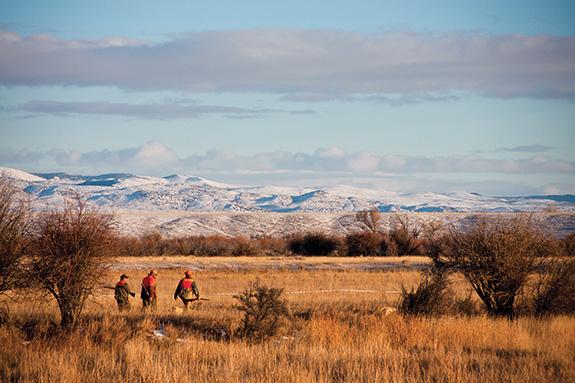Where the Roosters Live
Hunting waterways for pheasant.
The creek wasn’t much, even by the restricted standards of arid Montana prairie habitat—no more than a softball-pitch wide below the occasional beaver dams, frozen hard enough to support the dogs’ weight if not quite hard enough to bear my own. It was the dense cover along its banks that had made this meandering mile of cover so consistently productive for me over four decades of upland-bird seasons.
Even so, it would be hard to describe walking those banks as enjoyable, at least not in the way that walking along a trout stream is enjoyable. I could have made the hundred-yard hike across the barren stubble field from the truck on crutches, but the easy going ended where the grain did. Now I was thrashing my way through a tangle of thorns and willows, with the really tough going yet to come. Max and Maggie, my German wirehair pointers, had disappeared into a thick strip of frozen cattails, the nastiest vegetation to navigate on foot this side of an Alaska alder patch. Their beeping locator collars confirmed that they were on point, and the only gamebirds likely to have brought them to a halt there were ring-necked pheasants. The dogs had done their job, and now I had to do mine.
Montana east of the Continental Divide is dry country, with annual rainfall limited enough to qualify much of it as semi-desert. In this terrain, water in any form attracts a remarkable variety of game the way a magnet attracts iron filings. The importance of water to ducks and geese is obvious. There’s no better place to ambush a pronghorn buck during the early archery season than a prairie water source, and the same can be said of bow-hunting bull elk near creek-bottom wallows.
While the importance of waterways to upland bird hunters may be less apparent, it is no less real, especially when pheasants are the quarry. Sharp-tailed grouse and Hungarian partridge may be widely distributed with little regard to water sources, but pheasants are another matter. They don’t need surface water any more than the region’s other principal upland gamebird species, but they crave the secure habitat that dense creek-bottom vegetation provides. Pheasants may feed in the remains of the grain harvest, but they live in the cover beyond the reach of combine and plough, concentrating roosters along waterways even when they don’t contain much water.
That’s certainly where they were that crisp November morning, and it hadn’t taken the dogs long to find them. In sparse cover, running roosters can bedevil pointing dogs, but here the cattails had formed such a dense mat of vegetation that the birds chose to hide instead. I needed several minutes to reach them, but finally found Maggie honoring Max’s point, both dogs frozen as still as the reeds surrounding them save for their quivering tails. Nothing moved until a rooster erupted underfoot in a riot of noise and color. There wasn’t much to the chip shot that followed.
I was more interested in monitoring the behavior of the dogs. The veteran of a half-dozen seasons, Maggie did just what she was supposed to do, which was nothing but wait for the command to fetch. Young Max wanted to break, but I anchored him with a one syllable command: whoa! Wounded pheasants can pose a challenge even for experienced upland retrievers, but this bird had dropped from the sky like a stone and wasn’t going anywhere. Good thing, because the cattails were soon belching pheasants. By the time I climbed back up the bank, the dogs had delivered a three-bird limit.
My only regret was that it was all over so quickly.







